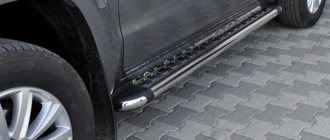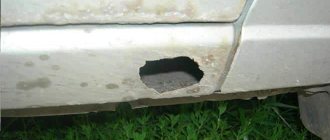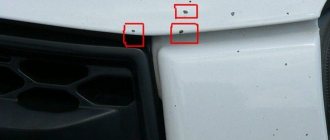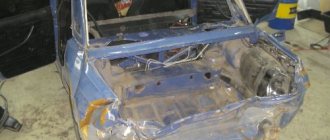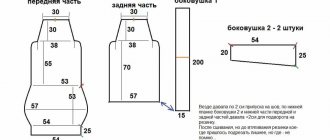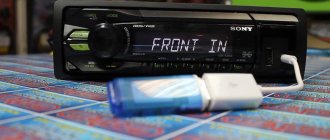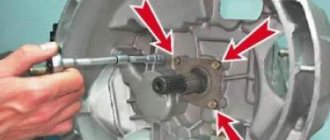Hello, dear and respected readers! We continue to delight you with new and, I hope, useful materials. This time we’ll talk about dent repair without painting.
Alas, in a large and fairly cramped city, such as Moscow, St. Petersburg, Krasnodar, Kazan or Yekaterinburg, for example, where the flow of cars is very impressive, it is not difficult to collide with other cars or get hit in the body. Although in cities like Tomsk, Voronezh, Kirov, Samara, Krasnoyarsk, Penza or even in Tula, there are no less clients at service stations who come to repair dents.
I myself have tested the body of my car more than once. Moreover, sometimes the fault was entirely mine, and sometimes other drivers openly offended me and did not even apologize. Well, that's a matter of the past. What did I do then? When there were Zhiguli cars, I took a heavier hammer and simply hit the metal from the inside. To be honest, it didn’t level out very well. But there was no choice, because the cost of repairs at the service station was beyond my means.
Already, being the owner of a more expensive car, I stopped using this homemade barbaric method. But I learned about PDR technology. This is a method of removing dents without painting, which is originally called Paintless Dent Repair.
In our country, the technology began to be actively used only recently, although in its homeland, in Europe and the USA, they have been resisting dents in this way for more than 50 years. Therefore, it was decided to tell you, our dear readers, about this method in detail.
Removing dents with compressed air
Materials needed for paintless dent repair :
- Clean soft cloth;
- Compressed air cylinder;
- Hairdryer;
- Thick fabric gloves with rubber coating.
Sequencing:
- Give access to the damaged area. Make sure that the deformed area can be easily reached from both sides. For example, open the hood if there is damage there.
- Heat the dent . Adjust the hair dryer to medium heat and keep it 10-15 cm from the surface of the car. Depending on the size of the dent, you may need to move the hairdryer up and down, right and left, to completely heat the area.
- Evaluate the malleability of the metal. Wearing gloves, evaluate the plasticity of the metal after 2 minutes of heating by lightly pressing on the center or outer edges of the dent. If you feel movement, then move on to the next step. Otherwise, continue warming up for another minute and test again.
- Spray compressed air. Shake the can of compressed air and spray onto the dent, holding the can upside down (no need to remove gloves). Continue spraying within the area of the damage until the metal returns to its original shape, usually 30 to 50 seconds.
- Pat the area dry. Gently wipe off any remaining condensation with a soft cloth.
LIFE EXPERIENCE
Today, people everywhere have learned how to straighten dents without repainting, while preserving the factory finish. If you act correctly on the deformed metal, the dent can be completely removed without damaging the durable and elastic paintwork. But an important nuance of the process is that you cannot simply put pressure on the dent. This way you cannot restore the original shape of the part. To understand this, imagine that the door is dented and the owner, inserting a rubber balloon inside, pumps it up. The loads will be distributed so that the broken metal of the dent will not straighten, but everything else will be pulled! You should locally influence some key points, then others, and so on. The matter is extremely painstaking. But they say that it is afraid of the master. And since there is not always direct access to dents from the inside, special levers and hooks are used - of various shapes, sizes, and rigidity. How to use them is again determined by the master.
Types of Dents
Based on the type of dent, they are divided into 3 groups:
- simple - small dents up to 5 mm deep, in most cases they are without scratches;
- complex shape - scratches and dents are quite deep, from 5 to 10 mm, the damage is very extensive;
- with holes - most often such scratches were obtained as a result of impacts from piercing and cutting objects; their characteristic features appear in torn metal.
We recommend learning how to remove small dents without painting.
Is vacuum restoration possible at home?
Repairing dents without painting yourself at home is only possible using levers. A microlift is too expensive for an ordinary car enthusiast. It makes the most sense to contact specialized workshops for restoration. Of course, you can always find a tool cheaper. But with this device it is difficult to achieve the same result as with the worldcrolift. You'll have to putty and paint.
1200 rub. for the photo report
We pay for photo reports on car repairs. Earnings from 10,000 rubles/month.
Write:
Removing dents after hail is a completely solvable problem for every car owner whose car has been exposed to this atmospheric phenomenon. To do this, one of four methods of paintless body repair can be used. Each of them has its own advantages and disadvantages, as well as the level of complexity of their implementation. In addition, they use different tools that should be available to craftsmen. We will discuss these repair methods in detail below.
External leveling with special equipment
External straightening of dents without painting is recommended in cases where it is not possible to perform this task from the inside for certain reasons. Elimination of defects in the damaged area is carried out using:
- adhesive applicators;
- glue;
- vacuum suction cup;
- fluoroplastic bumpers;
- mini-lifter.
Adhesive applicators must be secured in the damaged areas and not touched while drying. The mini-lifter allows you to pull out the dent by acting on the central point. The final stage is removing the glue. As a result, painting the damaged area is not required.
Other tools can be used as an analogue. This method is performed in a similar way, but a piston is attached to the center of the damage, with which it is pulled out. The principle is as simple as the previous method.
If the necessary equipment is not available, you can use a suction cup and hot glue at home. The nozzles must match the dimensions of the dent. They are fixed to the surface. Pulling occurs in a similar way to professional tools.
We use a microlift
Here's how else you can do car dent repair without painting yourself. The larger the damage, the larger the piston needed. Glue is applied to the latter. Next, the device is installed in the center of the place for 15 minutes. Then the piston is placed in the groove on the microlift and tightened with a nut. Next, gently press on the handle of the tool. The metal will stretch out - the piston will shoot off, and the remaining glue is removed with alcohol. A bulge will remain, which can be removed with a pencil and hammer. This process may need to be repeated several times until it is completely level.
Attachments
At the mastering stage, dent repair will not require very rich tools:
- straightening hammer with shock-absorbing strikers – 300 rubles;
- gas burner Super-Ego R355 – 1.8 thousand rubles;
- portable gas cylinder – 100 rubles;
- stainless steel trowel – 300 rubles;
- hot glue gun – 600 rubles.
In general, your expenses will not exceed 3.5 thousand rubles. If luck inspires you, then buy an inexpensive (3 thousand rubles) set of straightening tools Force F-911M1. You can work with it at a professional level and repair not only your car.
After the initial editing, the master proceeds to finishing the surface with hooks.
Having finished this matter, the tinsmith began to “massage” the dent from the inside. Crochet movements are soft, calculated, without fuss. The process is long - several hours with breaks for short rest for the eyes: they get very tired from the tension and blinding light of the lamp. It is curious that at first the master did not particularly care about the ideal shape of what he got - pits, tubercles. Some of the spectators even began to show concern, but after some time the irregularities began to miraculously disappear, and the Caddy’s wing began to look more and more like a new one. Such is high art! The result is shown in the last picture.
Features and Benefits
From the very beginning of its existence, PDR technology was extremely simple and did not allow eliminating serious defects on the body. Over time, it has been improved, so now it is possible to cope with fairly large dents and restore the previous quality of the body metal without damaging the paint layer.
The method is extremely simple, since now there is a special tool for it, a full set of devices. Some even decided to buy it for themselves, using it in the garage with their own hands.
But I’ll be honest, to remove small dents, you can try your luck and try to do everything yourself. But the technology has its own characteristics; craftsmen undergo special training to restore the car to the highest possible quality. You can practice on cars that you don't mind. And so they advise entrusting the process to specialists, whose address will not be difficult to find in your city.
The main advantages of PDR technology include:
- no need for painting work after removing a dent;
- little time spent on repairs and removal of defects;
- easy-to-perform local body repairs;
- a small number of stages required to carry out the work;
- affordable price, which is noticeably lower compared to traditional straightening, which additionally requires painting;
- maximum preservation of the quality of the paintwork on the car body;
- no need to look for paint to match the body color.
But you shouldn’t naively think that this is a magical method that allows you to carry out body repairs with one movement of your hand. The technology has its own nuances and certain limitations.
The dent was gone. And the master’s eyes need a long rest
The dent was gone.
And the master’s eyes need a long rest. The dent was gone. And the master’s eyes need a long rest. The described operations cost our accounting department 5,000 rubles. But everyone knows that repairing a wing using traditional methods would cost many times more. The most important thing is that our car, if you check its paintwork with instruments, will remain in the undamaged category! So why is putty still held in high esteem? It's simple. The instantly hardening polyester mass allows you to frankly hack things: you can fashion out of it even something that has long since rotted, then paint the car and get a lot of money from the owner. Of course, the owner of an ancient car can put up with layers of putty while “it” is still driving. But we advise the owner of a new car not to rush to the unfortunate masters under any circumstances. Traditional repair methods create a lot of problems - from corrosion of the dented area to troubles when selling: after all, putty cannot be hidden from modern devices.
So, not all technologies are worth mastering, ignoring specialists. Let us recall the joke: “It’s not at all difficult to walk along a rope stretched across a gorge, just keep your balance!” Would you like to try?
Assessing the repairability of a dent
Using a hair dryer to remove dents will not work on a car that is seriously damaged, but it will generally work great on small dents and gouges in certain areas of the car's body. To assess whether a dent is repairable using this repair method, you first need to pay attention to its location.
- The dent must be on a smooth surface such as the trunk, roof, door, hood, fender. It is much more difficult to remove dents on corner surfaces or parts this way, although it is quite possible.
- Measure the size of the dent. If it is about 8cm in diameter or larger (thus not deep) and has no visible paint damage, you have a better chance of getting results.
There are two ways to remove dents using a hair dryer:
- Use a compressed air cylinder;
- Use dry ice.
Both methods are most effective in restoring the metal to its original shape. In practice, many people prefer to use compressed air rather than dry ice because dry ice is harder to find. In any case, it is worth looking for rubber-coated gloves to protect your hands.
plunger
If dry ice is not found in every Russian home, then everyone probably has a plunger. However, to use this method it is better to purchase a new one - fortunately, these simple tools are inexpensive. And, of course, a plunger is only suitable for small dents, since its diameter is usually small.
The principle of operation is as simple as possible: you need to do exactly the same thing that is usually done with a plunger. That is, push and pull, completely covering the surface of the dent with a rubber valve and pouring a little water on top. Repeat until the problem goes away.
DIY straightening methods
Many car enthusiasts cannot afford to carry out repairs in a specialized service center, since this procedure can be quite expensive. In this regard, the question arises: how to remove a dent with your own hands. There is a list of basic methods for removing dents without painting, and all of them are quite simple, since they are done on their own and do not require the involvement of expensive equipment.
Did you know? The first automobile service shop opened in Boston in 1899.
Via magnet
Straightening, in other words pulling out, dents using the magnetic method is quite simple; it is enough to have a powerful magnet to which a handle is attached. This type of repair is ideal for smoothing out small dents.
The repair proceeds as follows:
- The first step is to clean the surface with a regular rag.
- Next, we attach the magnet to the body.
- Then, using the handle that comes from the magnet, we begin to pull out the dent.
- Be careful to only remove the dent and not retighten it.
Important! Before repairing, it is necessary to place something soft under the magnet so as not to scratch the paintwork.
Lever
This process is much more complicated than the previous one. To straighten a dent, you will need a rather expensive set of tools, namely levers.
This repair is carried out when the damage is voluminous and complicated. The whole process involves tapping out dents from the inside of the body. If necessary, you can dismantle some parts that will prevent you from getting to the damaged parts of the body. Hooks and levers have different lengths and shapes, in addition, they are curved at different angles.
- The work surface should be cleaned.
- Then, using a hair dryer, the part is heated to 40–50 °C.
- The edges of the bends need to be tapped and pressed onto the surface, thereby leveling the dent.
We recommend: Do-it-yourself replacement of brake discs on a VAZ 2110
The leveling technology is quite complex. The master selects the lever or hook he needs, uses pressure and tapping to level the surface.
Find out what dent removal kits are available and which one is best to choose.
Via applicator
Dents are retracted using a special kit called “Pops-a-Dent.” The set includes a rocker arm made of plastic, which is curved in a special way. To avoid damaging the surface, it has long legs with a rubberized sponge at their ends.
Hot-melt gun and a set of rods with silicone glue. The kit also includes attachments with different gripping areas, the soles of which are glued to the dent and thus straighten them.
Important! You should definitely see protruding glue through the technological holes; this gives good strength to the fastening itself.
Using the above-mentioned device, it is not difficult to cope with the defect:
- The first step is to degrease the dent itself and wipe it dry. There should not be a speck of dust left on the surface to be treated.
- Melt the glue and apply it to the nozzle as quickly as possible. Press it against the dent, twisting it a little and pressing it half a turn.
- After 2-3 minutes, you need to thread the handle through the eye of the nozzle.
- Then you need to screw the valve onto the thread.
- Slowly straighten the dent until it is level with the metal.
- After this, you should leave everything in this position for 5–7 minutes.
- We unscrew the valve, removing the arc.
- To separate the nozzle, we heat the plastic using a hair dryer, while turning it around.
If your driving skills are very careful, then you don’t have to buy the whole set. It will be enough to purchase only a glue gun. The arc can be made at home yourself, for example, from wood. Instead of rods, you can use an ordinary bolt, gluing its head to the defect.
We recommend that you familiarize yourself with the operating principle of a magnetic inductor - a device for removing dents without painting.
Thermal
The essence of this method is that the metal begins to level out due to a huge temperature difference. To implement this method you must have:
- construction hair dryer;
- compressed air.
The work algorithm looks like this:
- After the dent area is heated, it is cooled using compressed air.
- If the affected area is large, then it is heated in several places.
Pull out jams without painting - PDR technology
Repairing small dents without painting involves an exclusively mechanical method of influencing the damage, for which different methods can be used using compressed air and pressure changes, magnets, thermal heating, and shock-force effects.
- Removing dents with compressed air. The use of vacuum devices is based on a strong pressure difference, which pulls out dents on the car. First, the center of the damage is found, a vacuum suction cup is placed on it, and the depressed area is pulled out with a strong jerk, leveling the plane of the body. Typically, the method is used in combination with lever action from below.
- Removing dents with a magnet. A magnet is used to remove small defects; in addition, a soft cloth is placed under it so as not to scratch the coating. Move the magnet from the edge to the center, trying to stretch out the concave surface.
- Removing dents using PDR technology using a hair dryer. Heating the surface with a hair dryer is intended to make the metal more ductile and make it “remember” its original shape. In addition to a hairdryer, you will need a can of compressed air cooled to low temperatures (-78°C). First, the dent on the car is heated, then the surface is cooled by a directed contrast jet. A sharp temperature change leads to straightening of the concave surface - the method is called “heat shock”. If a gas cartridge is not available, you can use chilled water for this.
- Straightening dents without painting using the tapping method. Tapping is a universal method that is used in almost any case, since all others do not always give 100% results. The easiest way to straighten those parts that can be removed from the body. The front side is protected from damage and placed down; the reverse side is tapped with a straightening hammer. Small areas are corrected from the center to the edges. If the damage is extensive, tapping starts from the edges and continues towards the center. Aligning parts that cannot be removed is a little more difficult. The master must feel the metal in order to remove the dent by tapping it with a mallet. When working, the surface is protected with a soft lining so as not to damage the paintwork.
- Removing dents on a car body without painting using an adhesive applicator. For this method, a mini-lifter, a special applicator and thermal glue are used. A lifter pulls out the concavity, hooking it onto the applicator glued to the surface. After the procedure, the glue must be removed; the task is made easier by spraying a special chemical composition on it.
You can’t do this kind of work without a mini-lifter
Correction with a magnet
Repairing dents on a car without the need for painting using a magnet is one of the easiest ways to restore the surface of parts. For pulling, a magnet is used, which can be purchased at an auto parts store. It has enough strength to straighten small dents. This method removes shallow dents. If the defects are more serious, use another method.
Leveling damage with a magnet on a car is carried out in three stages:
- a cloth is placed between the magnet and the damaged surface to protect the paintwork;
- the magnet is attracted to the edges of the dent and gradually pulls back;
- the tool must be moved around the circle of damage until its central part is reached.
Percussion
You can straighten and completely remove a medium-sized dent by tapping it on the back side with a rubberized mallet. However, to do this you need to have access to the damage site. In the case of a door, this will require removing the door panel. Typically, repairs using this technology are carried out with mallets of various sizes, and to seal areas that are not accessible from the inside, hooks are used. However, in this case, traces will remain of them, which distinguishes this method for the worse from others discussed in this article. Read on to find out what else you can use to straighten a dent.
Rules for straightening a dent
- A body panel stamped from sheet metal acquires so-called “memory”. That is, if a change in the shape of the panel occurs, then this state is unnatural for it; the metal is in a stressed state and strives to take its natural shape. Your job is to relieve this tension.
- You should try to pull out the dent as quickly as possible after it forms. After a long time, the deformed metal, as it were, acquires a new “memory”, like stamped metal, the ductility of the metal decreases. If you do not pull out a dent for a long time, then there is a high probability that a trace of the dent will remain after it is pulled out.
- When a dent forms on the body, the metal not only deepens, the edges around the dent also rise above the general contour of the surface. The more convex the body panel, the more pronounced this is. It turns out something like a small volcano. For this reason, when straightening some dents, you need to tap the raised areas around them (sometimes not noticeable). For smooth dents that do not have wrinkles or damaged paint, light tapping by hand can be done in addition to the other pulling methods discussed in this article.
A dent on a convex or slightly convex surface may have raised areas along its edge.
- When the metal is heated, it is easier to straighten it. In professional body repair and PDR technology, adequate heating of the metal is used to straighten dents. This increases the elasticity of the metal and significantly reduces dent stress. Heating works better on larger dents. A hairdryer is used for heating. A regular hair dryer may not be enough, but it can also make the dent easier to pull out. When using a hair dryer, you should not stop in one place for a long time, as you can damage the paint. You need to use it at medium settings and constantly move it, at a distance of about 10 cm from the surface.
We recommend: How to distinguish retreaded tires from new ones
Using a Hot Glue Gun and Pull Tools
p, blockquote 12,1,0,0,0 –>
- For small dents, the pulling element can be glued to the center. Large dents extend from the edges.
- This way you can pull out the jammed stiffening rib, which “holds” the entire dent.
- At the same time, when pulling out dents, you need to tap the high spots, if any.
- To remove the pulling element, heat the glue with a hairdryer. Use isopropyl alcohol to loosen and remove the adhesive.
Pulling out a dent with a reverse hammer
p, blockquote 13,0,0,0,0 –>
You can make a reverse hammer to straighten out dents. To do this, you need a rod 3–5 mm thick and a piece of pipe. You can use hot glue to glue one piece of the hammer to the center of the dent. The principle is the same as when using pulling elements, only the hammer adds additional force through the inertia of the sliding load.
Read also: Dressing rooms in a niche (31 photos)
p, blockquote 14,0,0,0,0 –>
p, blockquote 17,0,0,0,0 –>
This kit also uses hot glue to secure the puller to the dent. The places where the pulling device will be glued must be degreased with isopropyl alcohol. You need to use a little glue.
p, blockquote 18,0,0,1,0 –>
You need to apply pulling pressure with the device and leave it for 5 minutes, periodically heating the edges of the dent. In general, when pulling with a special device (small bridge), the slow method works better than quickly pulling out the dent. Gradually reducing the size of the dent, you can do several repetitions. If there are raised areas around the dent, they must be carefully tapped with a special punch, which is included in the kit. You can read more about using the kit for straightening dents in the article “Pops A Dent kit, instructions on how to use it correctly.”
Repairing dents with a jack
Using a jack will help you pull out a dent in a car body with your own hands. The device is used to repair deep damage on the wings of a car.
Before carrying out work, dismantle the front turn signal and headlight. On the side of the dent, the jack rests against the heel (a rubber block is first placed under it); the lever of the device should rest against the opposite edge of the opening. The operation is stopped after the defect has been corrected, and the damaged area is covered with putty.
The lantern has been removed. Access to the reverse side of the damage is open. The dent is highlighted by a lamp.
We, of course, already knew that it was possible, for example, to first “pull out” a dent using devices like glued mushrooms, suction cups, etc. These days these are quite popular technologies. But not required. Our master did not waste time on them, but started with something else. Turning on the backlight, he thoroughly (and for quite a long time) tapped the entire perimeter of the dent with a plastic core. inside! Someone will say: where is the logic here? And here's what she's talking about. The metal in these places, gradually straightening out, seemed to pull the middle of the dent outward, which should have made subsequent actions easier with hooks. As we can see, what the master did was not easy even from the point of view of strength of materials, and even more so in practice!
Repair methods
Straightening dents is carried out not only from the inside, although this seems the most logical, but also from the outside. The technology of work largely depends on the area of damage and its location.
Firecrackers
This is what tinsmiths call dents that are large (up to several square decimeters) in area, but small (no more than a centimeter) in depth, with very gentle slopes. The metal in them has hardly changed in thickness. They got their name because straightening is accompanied by a clap.
The larger the area of the cracker, the easier it is to straighten.
Although this can be explained simply: the lever arm of the force - the distance from the center of the dent to the edge - is large. Sometimes it is enough to press it from the inside with your palm. Often it is a combined damage - at the point of application of force there remains a hole, which will have to be straightened separately.
Removing small dents with an impact tool
Fixing from the inside is the main way to repair such dents. To do this, you will have to remove the ceiling or door trim - the usual place for firecrackers to appear. If it does not lend itself to hand force, then, for example, a volleyball chamber can be placed in the technological cavity. A pressure of a couple of atmospheres will be quite enough. Small - you can still touch the metal with your hand - heating the edges will help speed up the process.
Medium dents
It is often not possible to straighten such a problem from the inside. For example, on a wing, the cavity of which is blocked by spars. If it is flat, without a break, then heating and hammering it through a trowel will help fix it.
- Heat the edges of the dent so that your hand feels noticeably hot when touched.
- Apply the trowel, making sure that it lies flat and does not touch any part of the body's relief with its edge. Tap the dent in a circle with light blows.
- Constantly control the heating (cooling is no better than overheating), don’t rush anywhere and persistently hammer the dent in a tapering spiral.
The construction trowel successfully replaces the professional tool “trowel”. Its handle is raised up, does not move around the body and does not interfere with the work of the hammer. It should be made of stainless steel, and the lower, working surface should be polished so as not to scratch the paint. During work, you must constantly wipe it with a cloth so that not the slightest speck remains on it, and degrease it.
Removing dents on the body surface using heating
There is a very exotic straightening method based on the use of temperature contrast. For it you need to prepare a can of carbon dioxide. These are used, for example, to charge airsoft weapons.
- Heat the dent in a spiral from the edges to the center.
- You spray carbon dioxide using the same principle.
- As the frost disappears, the metal straightens, subject to deformation forces arising from temperature changes.
Leveling in this manner may damage the paintwork. And the older the car, the higher the likelihood of such an outcome.
Small dents
Damage with a diameter of up to 1.5 centimeters can only be pulled out, since they are smaller than the hammer head and aiming along the edge is very problematic. Pulling is carried out with a bolt or screw with a head of suitable diameter and shape. It needs to be sanded to the desired configuration and polished.
The work area is degreased (as is the bolt head), after which the glue gun is used. After gluing the bolt, add glue on top, for reliability. The thread will help secure something like a handle or eyelet. The bolt is pulled behind them with whatever is available. But this must be done carefully, in several stages, constantly monitoring the process. The bolt may come off. Remove the adhesive with a solvent and repeat the process until the dent is straightened.
For such work, there is a professional tool - a set of polymer fungi of different sizes and shapes, as well as strikers. The firing pin consists of two parts - something like a bolt, the lower part of which hooks onto the figured protrusion of the fungus, and a massive bushing that slides along the stem. At the end of the striker there is a wide protrusion against which the bushing strikes.
Straightening a car body is an art. The master must feel the material and be able to predict its behavior. The skill is formed by long hours of training. Don't be afraid to put your hands in, though. The value of having such a skill will pay for all the costs. We advise you to initially practice on some car frame.
Replacing a part or part of it
If there is more serious damage, removing dents will not help restore the integrity of the part. In this case, the body element, or its most severely damaged part, is replaced with a new one. When replacing, it is necessary to find a part identical to the one being replaced. If a specific area is being replaced, the patch is cut from the same metal. Next, it is welded to the part being restored.
Minor damage to the body, chips, scratches and dents on the car can be repaired independently without repainting. Parts of the body that were not previously damaged are subject to restoration. If paint cracking, breaks or kinks appear, repairs without painting will not be possible.
This is what happens on the road: “if you don’t, it hits you,” in the sense that the accident is either your own fault, or the driver of another car is to blame. This is what I decided to write about and more.
So sadness happened to me: I was standing in the parking lot in the evening near the ESSEN shopping center, didn’t touch anyone, went off to stock up, and when I came back, the driver of a Lada Kalina came up to me and said that he hit my car. He says that while parking, he backed up next to my car and was distracted by the child in the back seat - the car rolled forward onto mine and dented the front passenger door. I am sad


